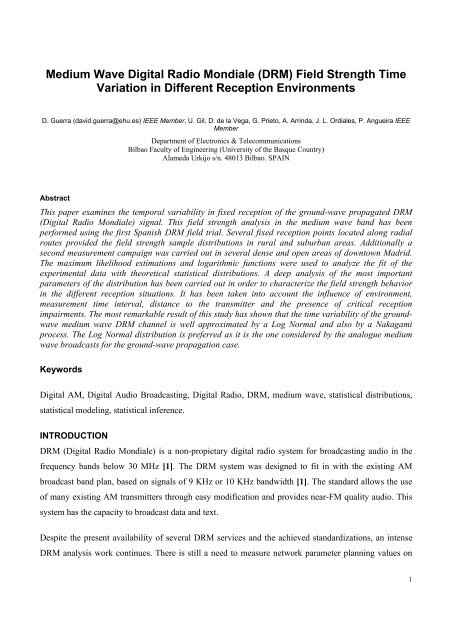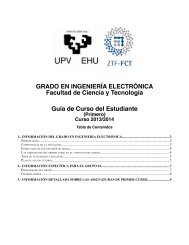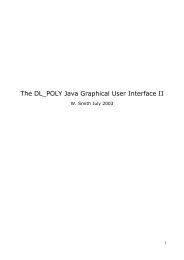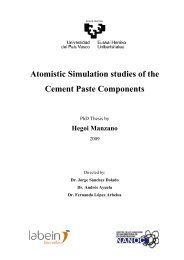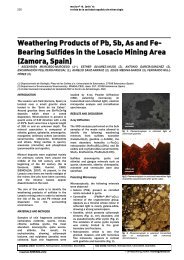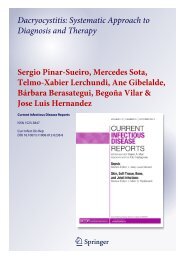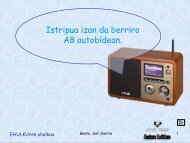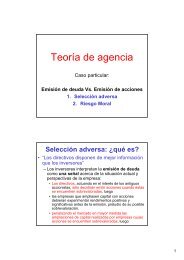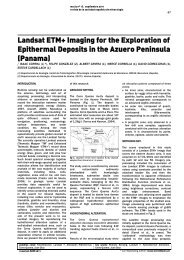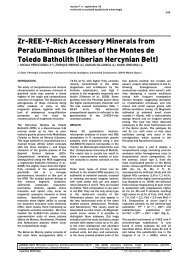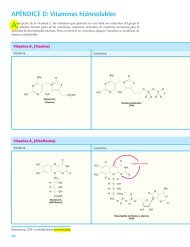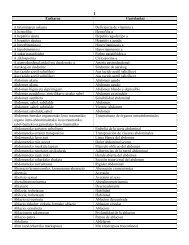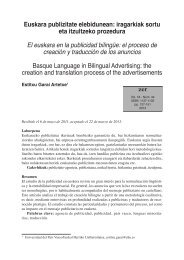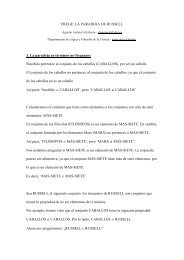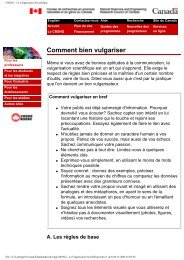Medium Wave Digital Radio Mondiale (DRM) Field Strength Time ...
Medium Wave Digital Radio Mondiale (DRM) Field Strength Time ...
Medium Wave Digital Radio Mondiale (DRM) Field Strength Time ...
You also want an ePaper? Increase the reach of your titles
YUMPU automatically turns print PDFs into web optimized ePapers that Google loves.
<strong>Medium</strong> <strong>Wave</strong> <strong>Digital</strong> <strong>Radio</strong> <strong>Mondiale</strong> (<strong>DRM</strong>) <strong>Field</strong> <strong>Strength</strong> <strong>Time</strong><br />
Variation in Different Reception Environments<br />
D. Guerra (david.guerra@ehu.es) IEEE Member, U. Gil, D. de la Vega, G. Prieto, A. Arrinda, J. L. Ordiales, P. Angueira IEEE<br />
Member<br />
Abstract<br />
Department of Electronics & Telecommunications<br />
Bilbao Faculty of Engineering (University of the Basque Country)<br />
Alameda Urkijo s/n. 48013 Bilbao. SPAIN<br />
This paper examines the temporal variability in fixed reception of the ground-wave propagated <strong>DRM</strong><br />
(<strong>Digital</strong> <strong>Radio</strong> <strong>Mondiale</strong>) signal. This field strength analysis in the medium wave band has been<br />
performed using the first Spanish <strong>DRM</strong> field trial. Several fixed reception points located along radial<br />
routes provided the field strength sample distributions in rural and suburban areas. Additionally a<br />
second measurement campaign was carried out in several dense and open areas of downtown Madrid.<br />
The maximum likelihood estimations and logarithmic functions were used to analyze the fit of the<br />
experimental data with theoretical statistical distributions. A deep analysis of the most important<br />
parameters of the distribution has been carried out in order to characterize the field strength behavior<br />
in the different reception situations. It has been taken into account the influence of environment,<br />
measurement time interval, distance to the transmitter and the presence of critical reception<br />
impairments. The most remarkable result of this study has shown that the time variability of the groundwave<br />
medium wave <strong>DRM</strong> channel is well approximated by a Log Normal and also by a Nakagami<br />
process. The Log Normal distribution is preferred as it is the one considered by the analogue medium<br />
wave broadcasts for the ground-wave propagation case.<br />
Keywords<br />
<strong>Digital</strong> AM, <strong>Digital</strong> Audio Broadcasting, <strong>Digital</strong> <strong>Radio</strong>, <strong>DRM</strong>, medium wave, statistical distributions,<br />
statistical modeling, statistical inference.<br />
INTRODUCTION<br />
<strong>DRM</strong> (<strong>Digital</strong> <strong>Radio</strong> <strong>Mondiale</strong>) is a non-propietary digital radio system for broadcasting audio in the<br />
frequency bands below 30 MHz [1]. The <strong>DRM</strong> system was designed to fit in with the existing AM<br />
broadcast band plan, based on signals of 9 KHz or 10 KHz bandwidth [1]. The standard allows the use<br />
of many existing AM transmitters through easy modification and provides near-FM quality audio. This<br />
system has the capacity to broadcast data and text.<br />
Despite the present availability of several <strong>DRM</strong> services and the achieved standardizations, an intense<br />
<strong>DRM</strong> analysis work continues. There is still a need to measure network parameter planning values on<br />
1
the field and also a need to analyze the behavior of the <strong>DRM</strong> system under several specific reception<br />
conditions. The ground wave medium wave frequency band propagation has been chosen to carry out<br />
the <strong>DRM</strong> measurement campaign analyzed in this paper.<br />
Existing analogue AM services planning tools in these bands are based on the field strength prediction<br />
models which could also be used for digital services [2]. Planning inaccuracies could be more critical for<br />
a digital service like <strong>DRM</strong> as field strength values lower than the reception threshold would cause the<br />
complete loose of availability of the service. Thus, digital radio systems need conscientious tuning of the<br />
existing field strength prediction models so that they can be accurate enough for network planning.<br />
In frequency bands bellow 30 MHz, ionospheric propagation in the HF band is known to be very<br />
unstable and this fact cause audio analogue services degradation to be unacceptable. That is the reason<br />
why time variability studies were carried out for this type of propagation and their results and<br />
conclusions can be found in ITU-R Recommendations P.842-2 [3] and P.1148-1[4]. Both<br />
recommendations are based on Recommendation P.1057-1 [5], which describes the probability<br />
distributions suitable for radio propagation. These recommendations are focused on Ionosphere<br />
ionization variations mainly due to variable solar activity.<br />
The effects of any ionospheric component on the variability of the signal of medium wave digital<br />
services are described in ITU-R Recommendation P.1321[6]. But in this same Recommendation, section<br />
4 Variability of ANNEX 1, it is stated that “The ground wave mode may be assumed to be unfading”. In<br />
APPENDIX 1 it is said that “The sky-wave component ei has a log normal distribution (see<br />
Recommendation ITU-R P.1057, equation (6)). For convenience it is supposed ostensibly that the<br />
ground wave component is also log normally distributed, and the final result is obtained by setting its<br />
standard deviation to 0 dB”. In Recommendation P.1321 the absence of experimental data of<br />
groundwave time variability is explicitly stated. It is simply assumed that groundwave time variability is<br />
negligible. The monitoring experience during the <strong>DRM</strong> field trials carried out in Madrid [7] showed that<br />
this assumption definitely was not true in urban reception environment. Consequently there was a need<br />
of a deeper analysis of <strong>DRM</strong> signal time variability.<br />
<strong>DRM</strong>, in the same way as other digital services in MW and higher bands, is very sensitive to variations<br />
of the received field strength. Information on the mean values of signals received is not sufficient to<br />
2
characterize the performance of those digital broadcasting systems. The variations in time, space and<br />
frequency also have to be taken into consideration [5].<br />
It is essential to know the extent and speed of signal fluctuations in order to be able to choose the<br />
parameters such as type of modulation, transmitted power, protection ratio against interference, diversity<br />
measures and coding method. In order to obtain reliable accurate planning, all these parameters should<br />
be analyzed by means of field measurements that can characterize the <strong>DRM</strong> coverage in a realistic way.<br />
First in this paper the objectives are explained. Second, some statistical analysis methods are reviewed.<br />
Then the measurement campaign is presented by describing the broadcasting network, the reception and<br />
measuring systems, the campaign planning and the methodology used in these tests. After the<br />
measurement campaign description, the data processing method is detailed and the associated results are<br />
described. Finally, the most relevant conclusions are summarized.<br />
OBJECTIVES<br />
The main objective of this work was to put under test the time variation statistical characteristics of the<br />
received <strong>DRM</strong> ground wave field strength in the medium wave band. This objective was sought under<br />
different reception conditions and for fixed reception. This main objective was divided into four analysis<br />
items:<br />
• Comparison between different statistical distributions and selection of the best fitting hypothesis.<br />
• Study of different factors which have influence in the signal behavior: distance to the transmitter, and<br />
reception environment.<br />
• Examine reception factors that cause special reception situations with a different best fitting<br />
distribution.<br />
• Comparison between best fitting distribution parameters and measured ones.<br />
STATISTICAL ANALYSIS METHODOLOGY<br />
The ability of statistical distributions to describe experimental data is highly demonstrated in numerous<br />
cases [8]. In this section the relationship between probability models and data is mathematically<br />
described.<br />
3
The application of the methods of probability to the analysis and interpretation of empirical data is<br />
known as statistical inference. Statistical inference is the process by which a generalization is made from<br />
a particular sample (field strength measured values) to the whole theoretical population. Statistical<br />
inference is traditionally divided into two areas: estimation and hypothesis testing.<br />
Statistical Estimation and Hypothesis Test<br />
The statistical distribution parameters play a crucial role in the inference process. In many situations the<br />
family of candidate probability models describing a phenomenon may be assumed, but the particular<br />
member of the family that best describes the phenomenon might be unknown. By convention, various<br />
symbols have come to be associated with the parameters of different distributions: for example µ and σ<br />
(mean and standard deviation) with the Gaussian distribution. However, to facilitate the discussion of<br />
parameters and estimates of parameters in general, we will let θ denote an arbitrary parameter. The<br />
symbol fY(y;θ1,θ2,....,θk) then, will denote a probability function whose k parameters to be estimated are<br />
θ1,θ2,....,θk. Every estimator W1, W2, ...Wk, by virtue of its being a function of the sample data, is itself a<br />
random variable. This means that its behavior for different random samples will be described by a<br />
probability density function. An estimator features several properties: unbiasedness, efficiency,<br />
minimum variance, consistency and sufficiency. In this paper the used method to inference a statistical<br />
population parameters is maximum likelihood estimation method.<br />
The estimators produced by maximum likelihood method are always functions of sufficient statistics [9].<br />
For certain, the equations that arise in carrying out the method of maximum likelihood are nonlinear and<br />
have solutions that can only be approximated. The Likelihood function has been used in this paper as:<br />
n<br />
∏<br />
i=<br />
1<br />
( ) = ( ) f ;θ<br />
=<br />
Y i y<br />
L L θ (1)<br />
As a general procedure for constructing estimators, we will look for the w that maximizes L(θ). Any<br />
value that does is said to be a maximum-likelihood estimate (or MLE) for θ. Often it will be easier to<br />
maximize ln [L(θ)] rather than L(θ). The logarithmic likelihood function value, shows which is the best<br />
fitting distribution to sample data. Higher the value is, better population fits data under analysis.<br />
Hypothesis testing helps to know if a hypothesized statistical distribution is valid for characterizing a<br />
data sample or not.<br />
4
When attempting to fit a model to observed data, a magnitude that describes how well the model reflects<br />
the data is needed. This magnitude will be the result of performing the Chi Square test. The Chi Square<br />
test is used to test if a sample of data came from a population with a specific distribution. The Chi<br />
Square test is defined for the hypothesis Ho (the data follow a specified distribution) and Ha (the data do<br />
not follow the specified distribution). For the computation of Chi Square Test Statistic, data are divided<br />
into n bins and the statistic is defined as:<br />
2<br />
( ObservedData<br />
− ExpectedData)<br />
∑<br />
χ =<br />
(2)<br />
ExpectedData<br />
The value of Chi Square Statistic is compared with a Chi Square population value of n-k degrees of<br />
freedom (k is the number of parameters of evaluating distribution and n is the number of bins of the<br />
histograms ). If Chi Square test statistic is lower than this value Ho is accepted. For the present study the<br />
Chi Square test and log-likelihood values have been chosen [9].<br />
MEASUREMENT CAMPAIGN<br />
Statistical methods described in the previous section will be applied to field strength data obtained in the<br />
<strong>DRM</strong> measurement campaign carried out in Madrid. In this section measurement campaign main aspects<br />
are explained.<br />
Measurement planning and transmission features.<br />
The tested <strong>DRM</strong> broadcast features are shown in Table 1. The AM transmitter facilities used for the tests<br />
are located in Arganda del Rey which is 25 kilometres from downtown Madrid.<br />
The measurement planning included different environments, i.e. rural, suburban and urban which<br />
allowed to obtain data with different types and levels of noise. The environment classification was done<br />
according to the following criteria:<br />
• Rural. Areas with scarce isolated buildings, open fields.<br />
• Suburban. Small towns. Residential areas with buildings not higher than two storeys.<br />
2<br />
5
• Urban. Big to medium cities. Areas where buildings are higher than two storeys and medium/low<br />
distances between them.<br />
The transmitter installed was the modulator model DMOD2 along with the amplifier TRAM 10 both<br />
from Telefunken Sendersysteme. This equipment was installed and adjusted to fulfill the ITU-R<br />
Recommendation BS. 1615 [10] radiated spectrum mask requirements for ITU Region 1.<br />
Measurement equipment and methodology<br />
The measurement equipment has been already described in a former paper that explained the field test<br />
itself and the reception quality results [7]. This section includes a brief summary of the measurement<br />
equipment and methodology emphasizing the aspects related to the time variability analysis. The<br />
reception and measurement system was composed of a mobile unit equipped for field strength<br />
measurements, amongst other <strong>DRM</strong> data. The antenna used in this measurement campaign was a fully<br />
characterized short monopole active antenna R&S HE010 mounted on top of the vehicle. The signal was<br />
then distributed to the rest of the equipment by means of a splitter system formed by two power dividers.<br />
RF power level values in the <strong>DRM</strong> signal bandwidth were provided by a Rhode & Schwartz ESPI3<br />
receiver. The control section was based on a laptop computer running software which configured and<br />
controlled the rest of the equipment, calculated on-the run statistics, coordinated the time/position/trip<br />
measuring, and conveniently stored all the captured and calculated data. Ancillary data, such as position<br />
coordinates and time, were provided by a GPS receiver.<br />
A <strong>DRM</strong> monitoring receiver and a Vector Signal Analyzer, VSA, completed the measurement<br />
equipment. The receiver decoded the audio signal or provided BER values. RF spectra were captured by<br />
the VSA.<br />
The measurement campaign was composed of 58 reception locations. At each location, several records<br />
were captured. Each data record was obtained measuring <strong>DRM</strong> reception parameters over a three minute<br />
interval. The measurement process was divided into records because at each location several <strong>DRM</strong><br />
modes were tested. The measurement system included a GSM based communication system which<br />
allowed remotely controlling the transmission parameters (<strong>DRM</strong> modes). Each data record contained<br />
reception data corresponding to a <strong>DRM</strong> mode. Three modes were tested in rural and suburban locations<br />
whereas in urban locations four different modes were tested. This results in three records for each rural<br />
6
and suburban location and four for each urban one. With respect to field strength analysis, the same<br />
output power was broadcasted despite de <strong>DRM</strong> mode, so all the records have the same statistical<br />
meaning in the analysis made in this paper.<br />
Summarizing, the database obtained in the field tests included a total number of 193 three minute long<br />
field strength data records. Amongst them, 76 records were measured in downtown Madrid (urban<br />
environment) and 117 records were located along five radials starting from the transmitter site: South<br />
West, South East, East, North and North West. These 117 records featured only man-made noise free<br />
locations (suburban and rural environments). All the measurement sites were located at transmitter<br />
distances in the range from 10 to 200 km.<br />
The ESPI3 field strength meter captured one signal level reading (dBµV) every 400 ms. <strong>DRM</strong><br />
parameters, such as the delay spread, the Doppler spread and the quality of the received signal, were also<br />
captured using the same sampling period. This measurement speed provided 450 instantaneous field<br />
strength values per record. As an additional feature of the measurement system, every minute online<br />
statistics were generated. These statistics were also stored in one plain text format file with some<br />
ancillary data like the GPS position of the measurement location. In order to obtain the field strength<br />
value, Em (dBµV/m), the reception antenna K factor was added to the signal level along with the<br />
attenuation of other elements of the reception system.<br />
Once the measured data were converted to field strength (dBµV/m), the statistical processing was<br />
performed with the corresponding linear values (µV/m) using Matlab’s Statistics Tool Box [11].<br />
Data censoring<br />
After obtaining the data corresponding to each measured record, all of them were plotted in order to<br />
make a first preliminary visual analysis. After this analysis, some of these records were discarded due to<br />
the presence of a rude field strength value change as the one shown in fig. 1.<br />
This urban reception record was affected by a lorry that parked beside the measurement vehicle in the<br />
middle of the three minute duration interval.<br />
7
In rural areas, three records were discarded due to similar reception anomalies and other four records<br />
were not measured because of the absence of GSM signal coverage to commute the transmission <strong>DRM</strong><br />
configuration. Therefore, the total number of analyzed records in rural areas was 56. In suburban areas<br />
four records were discarded and in urban areas five. Summarizing, the total records analyzed in rural,<br />
suburban and urban areas were 56, 50 and 71 respectively.<br />
Sample data<br />
The main statistic values (mean, variance, standard deviation, median, maximum and minimum) were<br />
calculated in their linear form from the measurement data (see Table 2). The relationships between<br />
linear and logarithmic values were immediate except in the case of the variance:<br />
σlog = 20*log(mean + σl/2)- 20*log(mean - σl/2) (3)<br />
The field strength exceeded the 99% of the time is another important statistic (e.g. used in coverage<br />
planning tools) so this value and the dB margin between the 50% and the 99% value were also<br />
calculated.<br />
Estimated data<br />
Estimated data calculation was carried out with common statistical distributions that are usually<br />
considered when trying to model radioelectric wave propagation. The usual candidates are described in<br />
depth by the ITU-R, Recommendation P.1057-1 [5], where some clues about the typical usage situations<br />
are also provided. Those distributions are Gaussian, Log Normal, Nakagami, Weibull, Rayleigh, and<br />
Rice [5][6].<br />
A Gaussian distribution is mainly encountered when values of the considered quantity result from the<br />
additive effect of numerous random causes, each of them of relatively slight importance. Log Normal<br />
distribution appears in a positive variable whose logarithm has a Gaussian distribution. Rayleigh<br />
distribution occurs in scattering phenomena. Nakagami describes the statistics of a signal at the receiver<br />
comprising of a scattered and not constant direct signal component and on the other hand, Rice describes<br />
the same with direct signal not constant component. Finally, Weibull distribution describes field strength<br />
with l.o.s. propagation in a scattering environment.<br />
8
Maximum Likelihood Estimation (MLE) parameters and estimated mean and variance were calculated<br />
for all mentioned statistical distributions. The logarithmic likelihood value was calculated in order to<br />
distinguish best fitting statistical distribution and the Chi Square test results allowed to decide if the<br />
approximation calculated with MLE was acceptable. If the Chi Square test value remained above 21.02<br />
the distribution was not considered to fit well the sample data behavior.<br />
RESULTS<br />
The best fitting distribution, estimated parameters and sample data statistics results are presented in this<br />
section. The results have been presented in several categories, in order to distinguish the rural, suburban<br />
and urban reception behavior.<br />
Best Fitting Distribution<br />
Rural and suburban environments<br />
In order to illustrate the results, Table 3 shows a rural location record example. The second row of Table<br />
3 shows the likelihood function inference values for the Log Normal, Gaussian, Nakagami and Weibull<br />
distributions, which are the best fitting ones among all the possible candidates proposed by the ITU-R<br />
[5]. The third and four rows show the Chi Square test and the threshold reference value to fulfill it<br />
respectively. Chi Square validates Log Normal, Gaussian and Nakagami distributions as good<br />
approximations to sample data.<br />
In the medium wave band, in order to facilitate the calculations in case of sky wave presence along with<br />
the ground wave [6], only the Log Normal distribution is usually selected when planning analogue AM<br />
services, so in this case being the four distributions good approximations, the right choice would be Log<br />
Normal. Other statistical distributions like Weibull, Rice, or Rayleigh led to worse likelihood and Chi<br />
Square values for this record. Figs. 2a and 2b confirm the results given in Table 3. Fig. 2a shows the<br />
difference between the recorded data, the Log Normal distribution CDF and the Weibull CDF. The Log<br />
Normal paper plot of fig. 2b illustrates even better how the Log Normal function describes the data<br />
behavior correctly.<br />
The overall results for rural and suburban environments are shown in Table 4. The second row in Table<br />
4 indicates the number of data records included in each category, the third one shows the distribution<br />
type and the fourth one the percentage of records with Log Normal and Weibull as the best fitting<br />
9
functions. Finally, the last row shows the number of records that have fulfilled the Chi Square test.<br />
Almost a 90% of the rural records the Log Normal is the best fitting function and the Chi Square test is<br />
fulfilled in half of them (26 cases). Log Normal distribution has a noteworthy higher percentage for both<br />
environments.<br />
Urban Environment<br />
Following the same procedure as done with rural and suburban environments, Table 5 and figs. 3a and<br />
3b show the results at one of the urban locations of the measurement campaign. This record is an<br />
example to illustrate that in urban environments, several locations showed a Weibull behavior.<br />
The reason behind this different behavior is the fast fading occurrence. Although Weibull is the best<br />
fitting distribution, the Chi Square test value demonstrated that the fitting was not perfect. This effect<br />
can also be observed as the difference between measurement data and Weibull CDF in the low field<br />
strength region (fig. 4b). Table 6 shows the overall results obtained for the 71 data records in urban<br />
location measurements. Weibull is the best fitting distribution in the 53% of the cases, but only four of<br />
them fulfill the Chi Square test. A 47% of the records are better approximated by Log Normal<br />
distribution.<br />
It was observed that Weibull distribution corresponding records contain fast fading due to traffic effects.<br />
This fading was due to large vehicles which passed near the reception antenna obstructing the<br />
transmitter-receiver path in the vicinity of the latter. The fading depth depended on vehicle size and on<br />
the actual distance between the blocking traffic and the receiver antenna. Figs. 4a and 4b describe this<br />
field strength behavior by means of a measured record at a location with frequent buses passing by. The<br />
pulse like line of fig. 4a represents the presence of a bus approaching reception antenna. When the field<br />
strength reached its minimum value the bus began going away from the reception antenna placed on top<br />
of the measurement van.<br />
The fading caused by a bus and lorries, observed during the field tests in Madrid, was in the range of 2<br />
to 3 dB. It should be noted that this result is dependent on the antenna type and height above ground<br />
level (vertical short dipole at 2.5 m above ground level in this measurement campaign).<br />
Estimated parameters<br />
10
After identifying the Log Normal and the Weibull as the best fitting probability functions, this section is<br />
devoted to the estimation of the statistical parameter values. This estimation has been done using the<br />
same measurement records described before in this paper. Depending on the distribution type, there are<br />
several ways to express the parameters of a distribution. Statistical analysis is used to characterizing<br />
both Weibull and Log Normal distributions in terms of two different parameters, the “scale parameter”,<br />
usually designed by η, and the “shape parameter”, usually designed by β. Both the scale and shape<br />
parameters can be obtained from the mean and the variance so the values described in this section will<br />
be mean and variance values for the sake of simplicity.<br />
Rural and suburban environments<br />
The estimated mean values are represented in fig. 5 as a function of the transmitter receiver path<br />
distance. Those values are represented with different symbols depending on the receiver environment<br />
type (triangles for urban, dots for suburban and crosses for rural).<br />
The estimated standard deviations for rural and suburban environment records had a mean value of<br />
0.092 and 0.125 dBµV/m respectively.<br />
Urban environment<br />
Urban estimated mean values had a noteworthy different tendency from the other environment estimated<br />
values of fig. 5 as they are lower for the same distance to the transmitter. Moreover for a distance around<br />
20 km from the transmitter site, urban estimated field strength mean values varied from 47 to 75<br />
dBµV/m for different records. The mean estimated standard deviation value was 0.388 dBµV/m. Fig. 6<br />
shows the cumulative distribution function plot of the standard deviation values of each field strength<br />
record. Standard deviation is depicted for all records separated in the above mentioned three reception<br />
environments.<br />
The standard deviation was found to be very similar in rural and suburban locations, and in any case<br />
lower than 0.5 dB for every data record in those environments. In the case of urban environments, the<br />
standard deviation value was lower than 1 dB in at least 90% of the analyzed data records. The overall<br />
conclusion is a low time variability of the received <strong>DRM</strong> signal despite of the environments which will<br />
ensure a good reception quality. Nevertheless, there will be some urban locations where traffic passing<br />
by the receiver could impair the audio quality if those locations are near the fringe of the coverage area.<br />
11
Calculated parameters from records<br />
Finally, the sample data allowed calculating two additional parameters. The first one was the<br />
instantaneous signal variability (difference between instantaneous and median received value over the<br />
three minute interval of each record. The second parameter was the difference between the median<br />
value, E50, and the value exceeded 99% of the time (E99), usually referred as the 50 to 99 percent<br />
margin. It should be noted that various planning criteria, such as required C/N and interference<br />
protection ratios are based on the values exceeded 99% of the time.<br />
The mean values of the variability calculated for all the records in rural and suburban environments are<br />
0.07, 0.10 and 0.31 dBµV/m respectively. The cumulative distribution function of the variability is<br />
shown in fig. 7. The values depicted in this picture give an idea of the variability of the received signal<br />
over the whole measurement campaign.<br />
In fig. 8, the cumulative distribution function of the difference values between 99% field strength and<br />
the median value is depicted for all measured records. Three different curves are shown, each one<br />
representing the CDF associated to each of the three considered reception environments. The<br />
intersection between the horizontal grey line in fig. 8 and each of the depicted curves, remarks the upper<br />
bound difference value between 99% and mean for the 90% of records.<br />
CONCLUSIONS<br />
This paper has described the ground-wave medium wave field strength time variability under different<br />
reception conditions. This study was made using data from a <strong>Digital</strong> <strong>Radio</strong> <strong>Mondiale</strong> field test carried<br />
out in urban, suburban and rural locations around Madrid (Spain). A total amount of 193 three minute<br />
field strength data records were measured. The best statistical distribution to characterize the medium<br />
wave field strength time behavior has been proposed and a set the critical parameter values of this<br />
distribution have been calculated from the measurement data.<br />
The Log Normal function has been found as the best fitting statistical distribution for rural and suburban<br />
areas. As expected, the Log Normal distribution mean value depended mainly on the distance from the<br />
transmitter site. In these cases, this distribution has fulfilled the Chi Square test for many of the records<br />
of both reception environments. This test has validated the characterization of the field strength time<br />
variation by means of the Log Normal distribution in rural and suburban environments.<br />
12
The behavior of the urban environment field strength depended highly on the density and type of<br />
vehicles passing by the measurement location. Some of the vehicles (buses) blocked the signal received<br />
by the antenna. It has been found that a bus driving close to the reception point, at a distance lower than<br />
2 meters, causes a field strength fading of 2 dB with the reception antenna is located at 2 meters a.g.l.<br />
This attenuation effect would be more important considering that the antenna height of a typical portable<br />
receiver varies from 1 to 1.5 meters a.g.l.<br />
Two time variation cases can be distinguished in urban environments. The Weibull is the best-fitting<br />
distribution for traffic-affected reception locations records while the Log Normal is the best-fitting one<br />
for the rest urban reception points. Despite being the best-fitting distributions, none of them fulfilled the<br />
Chi Square test.<br />
This paper has also shown that the mean value of the received field strength is highly dependent on<br />
environment factors such as traffic and building density. Those factors also cause higher standard<br />
deviation values in urban environment.<br />
The field strength value exceeded during the 99% of time has been calculated. The difference between<br />
this statistic and the signal field strength mean value increases with the presence of relevant urban traffic<br />
factors near the reception point such as buses and lorries but it still remains below 1.09 dB in 90% of the<br />
cases. This statistical fig. should be taken into account when designing <strong>DRM</strong> network planning tools.<br />
ACKNOWLEDGMENTS<br />
This paper is a result of the collaboration of <strong>Radio</strong> Nacional de España, RNE, VIMESA,<br />
TELEFUNKEN SENDERSYSTEMS and the University of the Basque Country and has been partly<br />
financed by the Spanish Ministry of Science and Technology under the MCYT project with code<br />
number TIC 2002-01340 and under the UPV/EHU – UE-A19 grant.<br />
REFERENCES<br />
[1] http://www.drm.org/system/globtechnical.htm<br />
[2] G. Braun, “Planning and Engineering of Software Links”, John Wiley & Sons Ltd.,pp. 280-281,<br />
1986.<br />
13
[3] ITU-R P.842-1,”Computation of reliability and compatibility of HF radio systems”, International<br />
Telecomunication Union, July 1999.<br />
[4] ITU-R P.1148-1,” Standardized procedure for comparing predicted and observed HF sky-wave<br />
signal intensities and the presentation of such comparisons”, International Telecomunication Union,<br />
March 1997.<br />
[5] ITU-R P.1321,”Propagation factors affecting systems using digital modulation techniques at LF and<br />
MF”, International Telecomunication Union, March 2005.<br />
[6] ITU-R, Recommendation P.1057-1 “Probability distributions relevant to radiowave propagation<br />
modelling”, International Telecomunication Union, February 2001.<br />
[7] D. Guerra, G. Prieto, I. Fernandez, J. M. Matias, P. Angueira, and J. L. Ordiales, "<strong>Medium</strong> wave<br />
<strong>DRM</strong> field test results in urban and rural environments", IEEE Trans. Broadcasting, Vol. 51, no. 4,<br />
Dec. 2005, pp. 431 - 438<br />
[8] J.D. Parsons,”The Mobile <strong>Radio</strong> Propagation Channel“”, John Wiley & Sons Ltd 2000.<br />
[9] V.K. Rohatgi, “An Introduction to Probability Theory and Mathematical Statistics”, John Wiley &<br />
Sons Ltd.,pp. 375-386 and 444-450, 1939.<br />
[10] ITU-R, Recommendation BS 1615 “Planning Parameter for digital sound broadcasting at<br />
frequencies below 30MHz” International Telecommunication Union, 2003.<br />
[11] http://www.mathworks.com/access/helpdesk/help/toolbox/stats/<br />
14
TABLE CAPTIONS<br />
ANNEX I<br />
LIST OF TABLES<br />
Table 1. Measurement campaign<br />
Table 2. Calculated and stored data<br />
Table 3. Best fitting values of a typical rural record<br />
Table 4. Best fitting results for rural and suburban areas<br />
Table 5. Best fitting values for a typical urban record<br />
Table 6. Best fitting results for urban areas<br />
15
Table 1. Measurement Campaign<br />
16
Table 2. Calculated and stored data<br />
17
Table 3. Best fitting values of a typical rural record<br />
Table 4. Best fitting results for rural and suburban areas<br />
18
Table 5. Best fitting values for a typical urban record<br />
Table 6. Best fitting results for urban areas<br />
19
FIGURE CAPTIONS<br />
ANNEX II<br />
LIST OF FIGURES<br />
Fig. 1. Discarded record<br />
Fig. 2a. Rural environment record and population<br />
Fig. 2b. Rural environment record and population on Log Normal paper<br />
Fig. 3a. Urban environment record and population<br />
Fig. 3b. Urban environment record and population on Weibull paper<br />
Fig. 4a. Passing traffic affecting urban environment record (example 1)<br />
Fig. 4b. Passing Traffic affecting urban environment record (example 2)<br />
Fig. 5. Estimated mean values vs. distance from transmitter for different environments<br />
Fig. 6. Estimated Standard Deviation cumulative distribution function in this measurement<br />
campaign<br />
Fig. 7. Sample record variability CDF<br />
Fig. 8. Difference between 99% and median value CDF<br />
20
Fig. 1. Discarded record<br />
21
Probability<br />
Probability density<br />
0.5<br />
0.4<br />
0.3<br />
0.2<br />
0.1<br />
0<br />
0.9999<br />
0.9995<br />
0.999<br />
0.995<br />
0.99<br />
0.95<br />
0.9<br />
0.75<br />
0.5<br />
0.25<br />
0.1<br />
0.05<br />
0.01<br />
0.005<br />
0.0005<br />
0.001<br />
0.0001<br />
Recorded data<br />
Log-Normal Distribution<br />
Weibull Distribution<br />
77 78 79 80 81 82<br />
<strong>Field</strong> strength (uV/m)<br />
Fig. 2a. Rural environment record and population<br />
Recorded data<br />
Log-Normal distribution<br />
Weibull distribution<br />
77 78 79 80 81 82<br />
<strong>Field</strong> strength (uV/m)<br />
Fig. 2b. Rural environment record and population on Log Normal paper<br />
22
Probability density<br />
Probability<br />
x 10-4<br />
8<br />
7<br />
6<br />
5<br />
4<br />
3<br />
2<br />
1<br />
0<br />
0.9999<br />
0.999<br />
0.99<br />
0.95 0.9<br />
0.75<br />
0.5<br />
0.25<br />
0.1<br />
0.05<br />
0.01<br />
0.005<br />
0.001<br />
0.0005<br />
0.0001<br />
Recorded data<br />
Log-Normal distribution<br />
Weibull distribution<br />
3.4 3.6 3.8 4 4.2<br />
x 10 4<br />
<strong>Field</strong> strength (uV/m)<br />
Fig. 3a. Urban environment record and population<br />
Recorded data<br />
Log-Normal distribution<br />
Weibull distribution<br />
3.4 3.6 3.8 4 4.2<br />
x 10 4<br />
<strong>Field</strong> strength (uV/m)<br />
Fig. 3b. Urban environment record and population on Weibull paper<br />
23
<strong>Field</strong> <strong>Strength</strong> (dBµV/m)<br />
<strong>Field</strong> <strong>Strength</strong> (dBuV/m)<br />
64<br />
63.5<br />
63<br />
62.5<br />
62<br />
61.5<br />
<strong>Field</strong> <strong>Strength</strong><br />
Bus presence<br />
61<br />
--NO<br />
60.5<br />
0 40 80 120 160 200 240<br />
<strong>Time</strong> (s)<br />
Fig. 4a. Passing traffic affecting urban environment record (example 1)<br />
93.5<br />
93<br />
92.5<br />
92<br />
91.5<br />
91<br />
90.5<br />
0 20 40 60 80 100 120 140 160 180<br />
<strong>Time</strong>(s)<br />
Fig. 4b. Passing Traffic affecting urban environment record (example 2)<br />
--BUS<br />
24
<strong>Field</strong> strength estimated mean<br />
value (dBµV/m)<br />
95<br />
85<br />
75<br />
65<br />
55<br />
45<br />
35<br />
Estimated Mean<br />
Urban<br />
Suburban<br />
Rural<br />
0 20 40 60 80 100 120 140 160 180 200<br />
Distance from transmitter (km)<br />
Fig. 5. Estimated mean values vs. distance from transmitter for different environments<br />
25
Cumulative probability<br />
1<br />
0.9<br />
0.8<br />
0.7<br />
0.6<br />
0.5<br />
0.4<br />
0.3<br />
0.2<br />
0.1<br />
Urban Data<br />
Suburban Data<br />
Rural Data<br />
0<br />
0 0.5 1 1.5<br />
Estimated Standard Deviation (dB)<br />
Fig. 6. Estimated Standard Deviation cumulative distribution function in this measurement campaign<br />
26
Cumulative probability<br />
1<br />
0.9<br />
0.8<br />
0.7<br />
0.6<br />
0.5<br />
0.4<br />
0.3<br />
0.2<br />
0.1<br />
0<br />
Rural Data<br />
Suburban Data<br />
Urban Data<br />
0.2 0.4 0.6 0.8 1 1.2 1.4<br />
Sample Data Variability<br />
Fig. 7. Sample record variability CDF<br />
27
Cumulative probability<br />
1<br />
0.9<br />
0.8<br />
0.7<br />
0.6<br />
0.5<br />
0.4<br />
0.3<br />
0.2<br />
0.1<br />
0<br />
Rural Data<br />
Suburban Data<br />
Urban Data<br />
0.5 1 1.5 2 2.5 3 3.5 4<br />
Difference between 99% and median value CDF<br />
Fig. 8. Difference between 99% and median value CDF<br />
28


